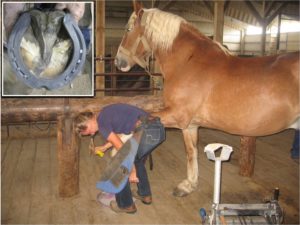Draft Horses

Maria Ostry of Bruno, Nebraska shoeing a Belgian Draft horse; Inset: Right Front foot of a Shire Draft horse shod with 18 inches of 1/2″ by 1 1/4″. Size 10 nails.
Draft or heavy horse shoeing is different from light horseshoeing. Draft horses move slowly. They often pull heavy loads. They are heavy and their feet need more protection than light horses. They are very strong, and though they are often gentle for most work, they sometimes resist shoeing.
A heavier, thicker stock shoe is required due to the size of the animal. Horses with smaller feet can be shod with a lighter section. Nail holes are punched over the white line and at the pitch of the hoof wall to insure safe and secure nailing.
Often, shoes are fullered to make it easier to extract the nails and to provide some traction. The fullering fills with dirt – you have dirt against dirt which provides more traction than steel against dirt. Heel calks from one-half to one inch in height are popular for farm and pulling horses. Toe calks one-half inch in height are usually only put on the hind shoes of farm horses. One-inch toe calks that are tilted forward, so they will dig in as the foot breaks over the toe, are put on the front and hind shoes of pullers. Horses used on asphalt road surfaces are often shod with Borium® or bolt-on replaceable rubber “tires.” Borium® can be put on with a forge or with an oxy-acetylene torch.
A wider web shoe is desirable since many draft horses are flat-footed and have a weak hoof-bone attachment that may be compromised by their weight and concussion on road surfaces. Although they need sole protection, they must not have sole pressure. The inside of the shoe must be seated out, sometimes called concaved (hollowed out), to prevent sole pressure and bruising when the sole descends slightly each time the horse’s foot bears weight.
A longer shoe is desirable to support the limb. It also should be a bit wider than the hoof from the last nail hole back to the heel to give more surface area to distribute concussion and prevent corns and deep flexor tendon injury.
The shoe heels should be made and fit to make room for the frog and allow easy cleaning of the foot. They should be finished straight up and down to provide the most ground surface area possible.
The outside branch of the shoes should be fit wider than the hoof since most draft horses are base narrow. The outside of the shoe should be boxed (filed on the foot surface) to reduce the chance of another horse in the hitch treading off the shoe. The inside branch should be safed (filed on the ground surface) to prevent injury when accidently treading on the opposite foot.
Toe clips should be used to prevent the shoe from shifting when the heavy shoe hits the ground. It is possible for the nails to be sheared off when a heavy horse’s foot strikes the ground. Clips on ½ by 1¼ stock should be an inch high and triangular in shape and without sharp points.
The nails should be appropriate to foot size allowing you to drive them 1/3 of the way up the hoof wall with the nail line parallel to the coronary band. Nails must be driven above the chips and cracks found in neglected feet. Broken out areas can be filled with Superfast or Adhere by Vettec™. Feet should be dressed to correspond to the shape of the coffin bone. The shape can be determined by looking down at the silhouette of the coronary band.
Horses that are not well trained for shoeing should be put in a stock or given a drug by a veterinarian to help them stand still when being shod. Each time the foot is put down it should be put down slowly to prevent the horse from falling. Also, dropping a foot with a heavy shoe on it can cause the coffin bone to fracture. Charges for shoeing drafts should be twice what you charge for a saddle horse since it is more than twice as much work.
Show draft horses are shod differently than working horses. The size and especially the width of the feet are exaggerated. Square shoes that have inserts welded on the inner web allow feet to be built to a greater size. These shoes are manufactured by Will Lent in Michigan. We have applied some for clients here at the school. We used a great quantity of Adhere or Superfast composite by Vettec™ to fill in the space and create square feet. We offer specialty courses of one week in length for those that are interested in draft horse type shoeing at www.butlerprofessionalfarrierschool.com. 1-800-728-3826.
Related Posts
-
There is a tendency today for people to get all they can whe...Mar 13, 2012 / 0 comments
-
Fall is upon us and temperatures are beginning to drop. This...Oct 05, 2018 / 0 comments
-
Osteomyelitis is distinguished from pedal osteitis in that t...Mar 21, 2019 / 0 comments
Blog Categories
- Anatomy
- Best Business Practices
- Conformation
- Current Events
- Customer Service
- Draft Horse Shoeing
- Equine Soundness
- Essential Anatomy Kit
- Farrier Careers
- Farrier training
- Foal soundness
- Horse Care
- Horse Foot Care
- Horse Owner Tips
- Horsemanship
- Horseshoeing
- Horseshoeing History
- Iron and Forge Work
- Student Spotlight
- Uncategorized
- Veterinary Care
Blog Archives
Contact Us
Butler Professional Horseshoeing School
495 Table Road
Crawford, NE 69339
(800) 728-3826
jacob@dougbutler.com
Subscribe to Our Blog
Get Our Free e-Book!
If you think you want to become a farrier (or know someone who does), this book can help you make that decision. Horse owners will learn the importance of choosing a qualified farrier and how to select the “right” one.
[ Get the e-Book Now! ]
- Follow:
